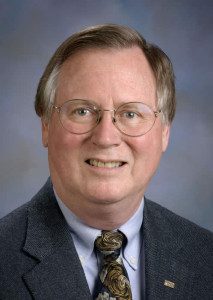 |
Professor B.S., Duke University (1965) M.S., Ph.D., Cornell University (1968, 1969) |
Semiconductor Physics
Solar Cells
Thin-film polycrystalline solar cells can be manufactured less expensively than traditional crystalline cells. The most promising light-absorbing materials, CdTe, CuInSe2, and related alloys, can be fabricated by a variety of techniques. The solar-cell efficiencies are still less than crystalline Si and GaAs, but the difference has narrowed considerably during the past few years. (Figure shows efficiencies in comparison to maximum for bandgap.) The Colorado State research program carefully analyzes these differences. Through a combination of precision measurements and careful analysis, approximately eight individual loss mechanisms are separated from one another, and quantitative values are assigned to each. The major remaining difference is that polycrystalline cells have forward currents two to three orders of magnitude greater than their crystalline counterparts. These currents, due to internal-grain boundaries that are not perfectly passivated, limit the voltage the cells can produce.
The solar cells program does not fabricate cells at Colorado State, but collaborates closely with six to eight other labs in the U.S. and abroad. Specific projects fall into four categories:
(1) Precision Measurement. Current and capacitance measurements are made as a function of voltage, temperature, light intensity, and light wavelength. They are also made as a function of time (see figure), since with less-than-ideal materials, long-lived states can alter response over several decades of time.
(2) Physical Model. This includes the passivation of CuInSe2 granules through oxidation of indium-rich surfaces and a general forward-recombination model for columnar grain structures.
(3) Analytical Techniques. Successful projects in recent years include the separation of parameters in the non-linear diode equation, reliable interpretation of capacitance measurements, and the interpretation of quantum efficiency in forward bias.
(4) Cell Comparisons. With a well-developed data base, it is straightforward to make detailed comparisons of to the features achieved by new cells those of their predecessors.
Materials Analysis
Some of the semiconductor measurement facilities are used for non-solar cell investigations. These projects are generally collaborative with others in the Physics and Electrical Engineering Departments. They include optical properties, photoluminescence, Hall measurements, and surface analysis.
